12 Most Sustainable Outdoor Clothing Brands: The Conscious Consumer’s Guide
Affiliate Disclosure
Hey fellow impactful ninja ?
You may have noticed that Impactful Ninja is all about providing helpful information to make a positive impact on the world and society. And that we love to link back to where we found all the information for each of our posts.
Most of these links are informational-based for you to check out their primary sources with one click.
But some of these links are so-called "affiliate links" to products that we recommend.
Why do we add these product links?
First and foremost, because we believe that they add value to you. For example, when we wrote a post about the environmental impact of long showers, we came across an EPA recommendation to use WaterSense showerheads. So we linked to where you can find them. Or, for many of our posts, we also link to our favorite books on that topic so that you can get a much more holistic overview than one single blog post could provide.
And when there is an affiliate program for these products, we sign up for it. For example, as Amazon Associates, we earn from qualifying purchases.
What do these affiliate links mean for you?
First, and most importantly, we still only recommend products that we believe add value for you.
When you buy something through one of our affiliate links, we may earn a small commission - but at no additional costs to you.
And when you buy something through a link that is not an affiliate link, we won’t receive any commission but we’ll still be happy to have helped you.
What do these affiliate links mean for us?
When we find products that we believe add value to you and the seller has an affiliate program, we sign up for it.
When you buy something through one of our affiliate links, we may earn a small commission (at no extra costs to you).
And at this point in time, all money is reinvested in sharing the most helpful content with you. This includes all operating costs for running this site and the content creation itself.
What does this mean for me personally?
You may have noticed by the way Impactful Ninja is operated that money is not the driving factor behind it. It is a passion project of mine and I love to share helpful information with you to make a positive impact on the world and society. However, it's a project in that I invest a lot of time and also quite some money.
Eventually, my dream is to one day turn this passion project into my full-time job and provide even more helpful information. But that's still a long time to go.
Stay impactful,
Amid growing concerns about the textile industry’s environmental impact, there is pressure to find greener clothes for your wardrobe, from office outfits to outdoor gear. Unfortunately, fashion greenwashing makes it harder for you and all other consumers to figure out which clothing brands offer the most eco-friendly garments. So, we had to ask: Which are the most sustainable outdoor clothing brands?
The most sustainable outdoor clothing brands are Patagonia, United by Blue, and Paka, which prioritize low-impact and high-performing materials while striving for circularity. In addition, VAUDE and Cotopaxi reduce carbon emissions and textile waste.
Whether you are searching for the perfect pair of trail pants or a weather-proof jacket to fit your chosen lifestyle without negatively impacting the soil, the water, the animals, and other people, there is a brand for you. So, let’s keep reading to learn more about the most sustainable outdoor clothing brands and how they ensure sustainable, ethical practices.
Here’s How We Selected the Most Sustainable Outdoor Clothing Brands
The fast fashion industry has pushed for many clothing categories, outdoor clothing included, to be trend-dependent and easily replaceable. Yet, the environmental impacts of making and landfilling clothes can be enormous, especially with items like waterproof jackets or high performance trail socks.
“Sustainable: The ability to be maintained at a certain rate or level | Avoidance of the depletion of natural resources in order to maintain an ecological balance”
Oxford Dictionary
The brands on this list were chosen based on their commitment and actions to promote sustainable practices while reducing the environmental impacts of the textile industry.
They are transparent about their materials, processes, and workforce management within their supply chain.
Some brands focus their efforts on reducing waste and optimizing natural resources while others strive to reduce the carbon footprint of their clothes.
All of these brands share the commitment to reshape the textile industry toward a more sustainable and Earth-friendly sector.
These Are the 12 Most Sustainable Outdoor Clothing Brands
Most Sustainable Outdoor Clothing Brands
Overall, these outdoor clothing brands are sustainable. Yet, they take various approaches to reduce environmental impacts and uphold ethical standards. Let’s dive into each brand and find out more.
Patagonia: Everyday Wear for Those Who Care
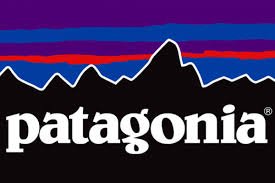

“Together, we can prioritize purpose over profit and protect this wondrous planet, our only home.”
Patagonia
🌎
How do they ensure their sustainability?
Patagonia puts sustainability at the center of their operation. They work to reduce, rather than simply offset, carbon emissions where it matters the most: in the supply chain and material manufacturing. They reduce their carbon footprint by removing high-impact virgin fossil-based fibers from their collections, using “Environmental Profit and Loss” to guide their production decision, and helping their suppliers to cut emissions. For example, Patagonia’s fall 2023 collection was made up mostly of preferred materials (91% by fabric weight), including Regenerative Organic Certified fibers, hemp, man-made cellulose fibers, recycled cotton, and recycled polyester. On top of that, Patagonia’s Worn Wear Program encourages customers to repair and recycle their products, extending the textile lifecycle and reducing waste. Lastly, Patagonia is certified as a B Corporation and a Bluesign® brand.
🌐
How do they ensure their ethics?
Patagonia commits to fair trade practices. Through the partnership with Fair Trade USA, they currently produce 86% of their clothes in 20 Fair Trade Certified™ factories. Patagonia pays a premium for every item produced in such factories, accumulating in a fund for workers to use in their chosen community projects, whether in healthcare or parent support or to withdraw as a cash bonus. Additionally, they have various social responsibility programs to prevent harm and create positive impacts on the lives of apparel workers in their supply chain. These include the Fair Labor Association, the Living Wage Program, the Migrant Workers Program, and the Responsible Purchasing Practices. Patagonia is also fully transparent about the locations of their facilities and suppliers.
🤝
Are they part of any giving-back programs?
Since 1985, Patagonia has pledged 1% of sales annually to environmental causes. They have awarded over $89 million in cash and kind donations to domestic and international grassroots environmental groups, making a difference in their local communities. In 2022, the founder of Patagonia gave away his family’s ownership of the company to the newly created Patagonia Purpose Trust and the not-for-profit organization Holdfast Collective, ensuring that all future profits from the company are used to fight the climate and extinction crisis.
🛍️
What is their product range?
- Best for: kidswear, menswear, womenswear
- Product range: shirts, pants, jackets, blazers, hoodies, sweatshirts, T-shirts, shorts, plus-size
- Price range: $$$
- Size range: XXS–XXXL
United by Blue: Backpack and Outdoor Apparel That Designs Out Waste at Both Ends of the Life-Cycle

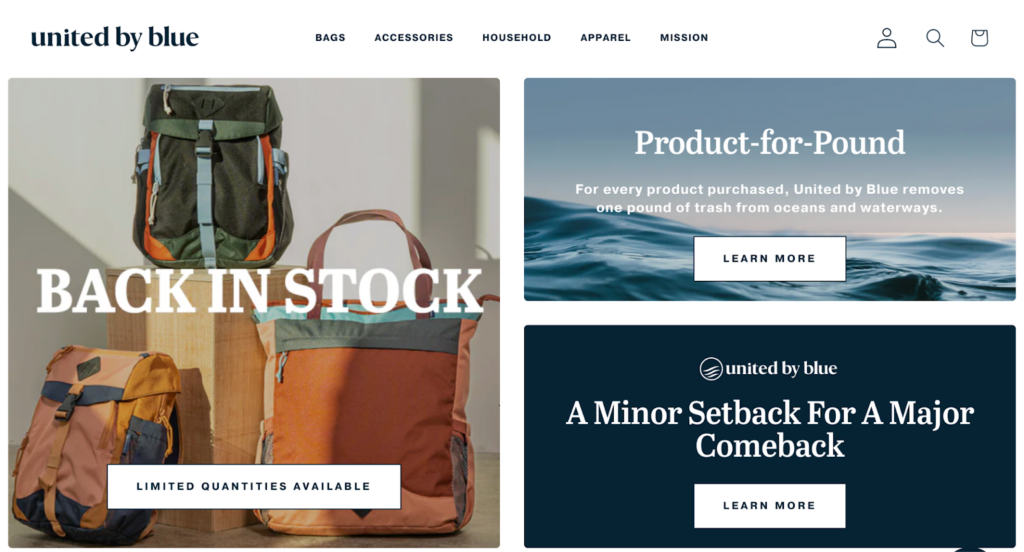
“Our hope is that through engaging cleanups, better business practices, and trash-cleaning products we can clean up the planet and the fashion industry one sustainable choice at a time. ”
United by Blue
🌎
How do they ensure their sustainability?
United by Blue ensures sustainability by designing out waste. In particular, they make durable products from sustainably sourced, low-impact materials. They also make them in factories with some of the highest social and environmental health certifications on a slow fashion timeline. Firstly, they source a high proportion of lower-impact materials. They prioritize biodegradable, regenerative fibers, recycled materials, and deadstock fabric. United by Blue’s products are also based on some of the most sustainable fabrics, including organic cotton (with GOTS and OCS certifications), recycled cotton (with GRS and OEKO-TEX® certifications), recycled wool (with RWS certification), recycled polyester (with GRS certification), recycled nylon (with GRS certification), and hemp (and SofthempTM). With high-impact fabrics like cashmere and viscose, the brand opts for the most sustainable options, including recycled cashmere and Lenzing’s EcoVero™ (a sustainably sourced viscose manufactured in a closed-loop system). Furthermore, United by Blue commits to having no single-use plastic within their packaging. Since 2022, all direct-to-consumer shipments have been packed in compostable poly bags, paper and cardboard boxes, and recyclable kraft tapes. Regarding their climate impact, the brand measures and reduces carbon emissions, especially in four key areas: shipments, production, energy, and stores. Their emission reduction measurements focus on reducing and consolidating shipments, transporting overseas products by boat, seeking renewable energy options, and prioritizing energy-efficient appliances, lighting, and materials in their physical stores and offices.
🌎
How do they ensure their sustainability?
United by Blue binds all their suppliers with a Code of Conduct covering all of ILO’s Fundamental Principles and Rights at Work. They trace most of their supply chain and publicly share on their website their manufacturing partners, which are certified with some of the top sustainability standards (Bluesign®, Business Social Compliance Initiative Code of Conduct – BSCI, Global Organic Textile Standard, Social Accountability International – SA8000, and Worldwide Responsible Accredited Production – WRAP). Regarding animal welfare, they source wool certified by the Responsible Wool Standard, ensuring the ethical treatment of sheep in their supply chain.
🤝
Are they part of any giving-back programs?
United by Blue removes one pound of trash from oceans and waterways for every product purchased. They achieve this by organizing community, corporate, DIY, high-yield, and international cleanups.
🛍️
What is their product range?
- Best for: menswear, womenswear
- Product range: bags, wallets, blazers, beanies, scarves
- Price range: $$$
- Size range: S–XXL
Paka: Outdoor Clothing Made With Traceable Alpaca Wool

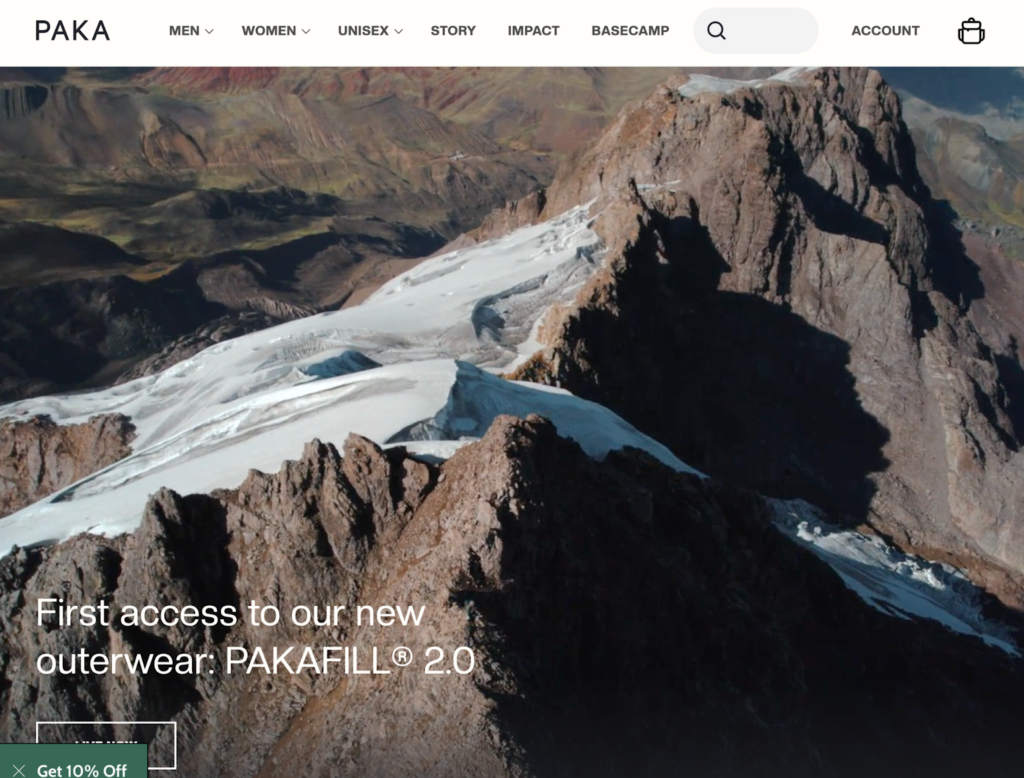
“Paka was created to bring you closer to where your clothing comes from, what it’s made of, and who made it.”
Paka
🌎
How do they ensure their sustainability?
Paka prioritizes sustainability by innovating and making low-impact, high-performing fabrics with ethical alpaca wool. In particular, they source alpaca wool from small-scale, family-owned herds. Each herd contains 60 to 90 animals roaming free throughout the Peruvian Andean Highlands. After the fleece is shorn, the fiber is collected and separated by hand before being colored (if needed) with environmentally friendly dyes certified by OEKO-TEX® and GOTS. Half of the energy used in their alpaca wool spinning process comes from solar energy. Further down the life-cycle in the transporting stage, Paka alpaca products are delivered carbon-neutral through their partnership with Ecocart. The packaging is also fully biodegradable.
🌐
How do they ensure their ethics?
Paka ensures their ethics by making their alpaca wool products fully traceable, from free-roaming alpacas up in the Andes Mountains to customers’ homes in the US. The 100+ Quechua women weavers who make Paka’s products are employed by the brand and paid 4 times the family living wage. Regarding alpaca treatment, Paka uses a special technique (Inca Esquila) to minimize the time and stress posed upon the animal during the shearing process.
🤝
Are they part of any giving-back programs?
Through their partnership with Peruvian Hearts, Paka supports the education of underprivileged Peruvian young women with 1% of their annual revenues. Another 1% of their sales supports regenerative agriculture and alpaca families. Additionally, they provide free weaving training for women who want to learn a skill, as well as a “Wawa Wasi” (daycare) in the neighborhood, with full-time supervision and a trained psychologist to enable mothers to go to work. Lastly, Paka is helping to build an NGO that preserves the Inca traditions.
🛍️
What is their product range?
- Best for: women’s and men’s knitwear
- Product range: jackets, sweaters, hoodies, baselayer, T-shirts, joggers, socks, underwear, accessories
- Price range: $$$
- Size range: XXS–XXL
VAUDE: Outdoor Gear and Activewear Where Performance Meets Ecology


“We design with a focus on minimal material consumption, try to avoid waste and design products that are timeless, durable and repairable.”
VAUDE
🌎
How do they ensure their sustainability?
VAUDE prioritizes sustainability by creating a counterbalance to resource-consuming lifestyles. They achieve that by making durable and versatile products for life, minimizing waste during manufacturing, and enabling longer product lifespan with maintaining, repairing, donating, and upcycling guidance. VAUDE opts for materials that combine technical performance and ecological responsibility. An example of this is their use of merino wool, a natural fiber suitable for a warm and water-repellent protective layer that is ideal for mountain sports. Meanwhile, they lower the impact of this fabric by adhering to the Responsible Wool Standard and the Global Organic Textile Standard for virgin organic wool and increasing the content of GRS-certified recycled wool in their collection. Furthermore, their products have been certified by Bluesign® and Green Button. Regarding their impact, the brand sets Science Based Targets (SBTi), measures the total carbon footprint, and implements reduction measures in hotspots like material, energy, and transport. Since the beginning of 2022, VAUDE has been a carbon-neutral company, achieved through fully offsetting their global greenhouse gas emissions in the My Climate’s climate change mitigation project in Vietnam, their most important country of production.
🌐
How do they ensure their ethics?
VAUDE ensures ethical practices for both humans and animals involved in their operation. They work with the Fair Wear Foundation to monitor their final stage of production, ensuring safe working conditions and fair wages for factory workers. They also audit 100% of their producers in high-risk countries. Additionally, VAUDE has a basic policy to support diversity and inclusion in their direct operations and supply chain. Regarding animal rights, they follow the Responsible Wool Standard, appropriately addressing sheep’s welfare and the land they graze on.
🤝
Are they part of any giving-back programs?
VAUDE donates the products that can’t be repaired but are still perfectly functional to FairWertung. In 2021, VAUDE donated products with a merchandise value of approximately €339,000 (approximately $375,000 USD) to the network, which makes clothes affordable via charity shops or second-hand stores.
🛍️
What is their product range?
- Best for: sportswear (cycling, hiking, skiing) and urban outdoor clothes for women, men, and kids
- Product range: jackets, hoodies, sweaters, shirts, vests, pants, shorts, skirts, functional underwear
- Price range: $$$
- Size range: XS–XXXL
Cotopaxi: An Outdoor Brand Working to Alleviate Global Poverty


“To prioritize sustainability for both people and planet, we consider every phase of a product’s lifecycle, including partnering with factories that treat workers right, sourcing sustainably minded materials, and making durable gear that lasts.”
Cotopaxi
🌎
How do they ensure their sustainability?
Cotopaxi ensures sustainability by designing their products and sales orders in a way that creates as little waste as possible. In 2022, 98% of their products contained repurposed, recycled, or responsible materials. Cotopaxi’s eco-preferred fibers include recycled fibers (cotton, wool, cashmere, polyester, nylon), organic fibers (cotton, linen, hemp, silk), TENCELTM Lyocell, and wool that is certified to the Responsible Wool Standard. They also prioritize products that are timeless and durable while offering customers pathways to repair, resell, and return their products, promoting slow-fashion principles to avoid overconsumption and unnecessary waste. As of 2022, Cotopaxi has eliminated all single-use plastic packaging from their entire supply chain. Additionally, Cotopaxi monitors, measures, and reports on their material environmental impacts, including all greenhouse gas (GHG) emissions, to reduce and responsibly offset their entire carbon footprint. Cotopaxi also works with Pachama and BEF to purchase carbon offsets from verified and vetted projects. Last but not least, they request water usage measurement and water reduction targets from their Tier 1 and Tier 2 suppliers in order to reduce their overall water impact.
🌐
How do they ensure their ethics?
Cotopaxi has a Code of Conduct covering all of the ILO’s Fundamental Principles and Rights at Work. They trace most of their supply chain and visit their suppliers regularly. Additionally, they ensure payment of a living wage in some of their supply chain.
🤝
Are they part of any giving-back programs?
Giving back is at the core of Cotopaxi’s operation. The Cotopaxi Foundation, founded in 2018, provides grants to nonprofits that help communities facing extreme poverty, including but not limited to organizations that provide healthcare, facilitate education, promote gender equality, and respond to humanitarian crises. Cotopaxi also became a member of 1% for the Planet in 2022, committing to donate 1% of sales to causes that support a healthier planet for all.
🛍️
What is their product range?
- Best for: menswear, womenswear, kidswear
- Product range: backpacks, travel bags, day bags, hip bags, bag accessories, jackets, vests, bottoms, T-shirts, hoodies, sweatshirts, activewear, accessories
- Price range: $$
- Size range: XS–3XL
Outerknown: Stylish Clothes Made Sustainably and Ethically


“We are driven by a passion for responsible action, courageous change, and great clothes.”
Outerknown
🌎
How do they ensure their sustainability?
Outerknown places sustainability at their core by using eco-friendly materials such as hemp, organic cotton, recycled cotton, and responsible wool in their clothing, reducing the environmental impact. In 2022, these preferred fibers accounted for 95% of their collection. The brand’s Outerworn platform also offers customers a chance to buy and sell pre-loved pieces, contributing to closing the loop in fashion. Furthermore, they partner with Project Vermont to give new purpose to materials that would otherwise end up in landfills. Additionally, Outerknown strives to reduce their footprint by working with two B Corp Certified suppliers and having 8 facilities running on renewable energy.
🌐
How do they ensure their ethics?
Outerknown maintains ethics by promoting the highest labor standards in alignment with the Fair Labor Association. They also publicly share their Code of Conduct, which covers all of the ILO’s Fundamental Principles and Rights at Work. Furthermore, Outerknown provides Fairtrade Premium, which has improved workers’ livelihoods in their supply chain via workers’ chosen programs in healthcare, education, accommodation, and financial independence.
🤝
Are they part of any giving-back programs?
Outerknown gives back to non-profits that align with their values and help make a larger impact. They work with organizations like Brother Benno, The Ocean Cleanup, Ocean Conservancy, Surfrider Maui Chapter, Surfrider Foundation, and Everytown.
🛍️
What is their product range?
- Best for: menswear, womenswear
- Product range: shirts, pants, T-shirts, tops, sweaters, dresses, hoodies, shorts, denim, jackets, blazers, jumpsuits, playsuits, swimwear
- Price range: $$$
- Size range: XS–XL
Superstainable: Uncompromising Outdoor Wear

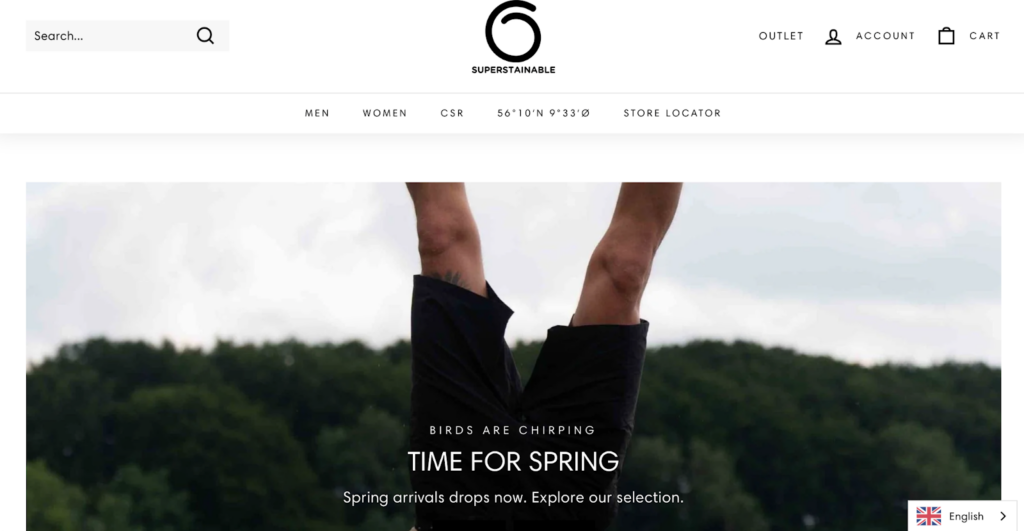
“Our brand relies on three key elements and values of minimalistic design, greatest quality and functionality to withstand any weather conditions.”
Superstainable
🌎
How do they ensure their sustainability?
Superstainable ensures their sustainability by sourcing a high proportion of eco-friendly materials. In particular, they opt for either organic or recycled materials to lower their impact. Their organic fabrics, including merino wool and cotton, are certified with the Global Organic Textile Standard, while their recycled polyester fabrics have the Global Recycle Standard certification. Regarding their climate impact, they calculate the carbon footprint of certain products and share the information to help customers make the right choice for outdoor gear that is low-impact and has a long lifespan.
🌐
How do they ensure their ethics?
Superstainable is fully transparent about their supply chain, including tier 1, 2, 3, and 4 suppliers. They also audit most of their supply chain, including the second and final stages of production. Regarding animal welfare, they work with GOTS-certified suppliers to guarantee that they can track all of their wool and ensure the welfare of the sheep (i.e., no mulesing practice).
🤝
Are they part of any giving-back programs?
Superstainable is not known to be part of any giving-back programs.
🛍️
What is their product range?
- Best for: womenswear, menswear
- Product range: base layers, mid layers, fleeces, jackets, knitwear, T-shirts, accessories
- Price range: $$$
- Size range: XS–XXL
éclipse: UPF 50+ Clothing for Sunny Destinations


“Eclipse uses high-tech, UPF 50+ (maximum sun protection) thermoregulating (temperature control) fabric to keep you cool and recycled fabric (from plastic bottles) to minimize environmental impact. All products are made in the USA with the highest environmental and worker protection standards.”
éclipse
🌎
How do they ensure their sustainability?
éclipse promotes sustainability by sourcing low-impact textile and packaging materials, reducing textile waste, and keeping their carbon footprint low. Firstly, they use a medium proportion of recycled fabrics to lower the impact of using functional synthetic materials. Specifically, the brand has been transitioning to recycled polyester across all styles, aiming to offer the same fit and feel as their thermoregulating 37.5™ fabric. Additionally, they work with a Bluesign®-certified partner to transition to compostable packaging and shipping materials. Secondly, éclipse minimizes textile waste by operating on limited production runs and taking back used éclipse apparel to keep them in circulation longer and out of landfills. Lastly, the brand manufactures locally in the US to reduce transport carbon emissions.
🌐
How do they ensure their ethics?
éclipse traces most of their supply chain. Their Supplier Code of Conduct also covers four of the ILO’s Fundamental Principles and Rights at Work.
🤝
Are they part of any giving-back programs?
éclipse plants a tree with every order.
🛍️
What is their product range?
- Best for: menswear, womenswear
- Product range: hoodies, sweatshirts, T-shirts, accessories
- Price range: $$
- Size range: S–L
Silverstick: Organic Cotton Clothing Purposely Built for the Natural Habitats Outdoors

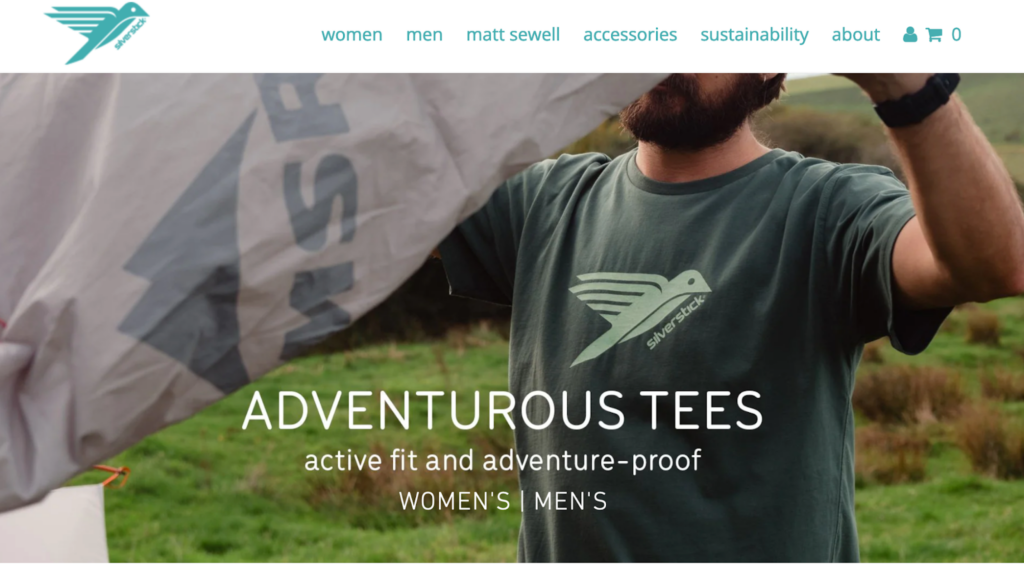
“We have only one planet to explore. Our clothing is designed to leave only footprints.”
Silverstick
🌎
How do they ensure their sustainability?
Silverstick promotes sustainability by using low-impact natural fabrics and reducing carbon emissions. The brand sources a high proportion of Aegean organic cotton certified by the Global Organic Textile Standard (GOTS), meaning that cultivation uses no chemicals such as pesticides and insecticides and relatively less water. Also, the manufacturing factory is located near where the cotton is grown, reducing the transporting carbon emissions. Silverstick further reduces their impact during manufacturing by opting for low-impact dyes that do not contain harmful substances and water-based inks that are plastic-free and certified by OEKO-TEX®.
🌐
How do they ensure their ethics?
Silverstick traces most of their supply chain and audits most of their final production stage annually.
🤝
Are they part of any giving-back programs?
Silverstick donates 10% of the proceeds from the sales of their Matt Sewell collection to Wildcard, a grassroots environmental conservation organization.
🛍️
What is their product range?
- Best for: womenswear, menswear
- Product range: coats, jackets, knitwear, shoes, sneakers, boots, pumps, heels, skirts, dresses, accessories
- Price range: $$
- Size range: S–XXL
The Level Collective: Organic Cotton Apparel and Accessories That Are Designed for Work and Play in the Wild

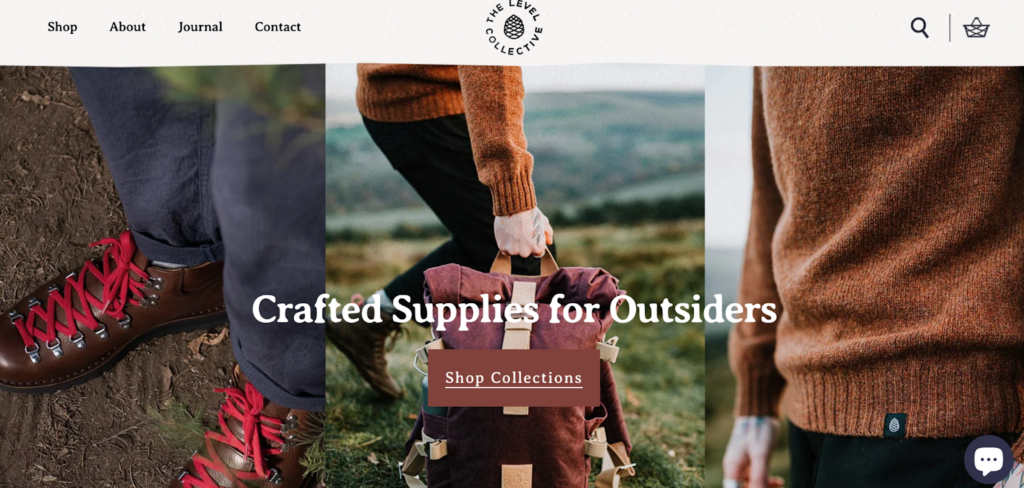
“We lead by example, putting people and planet before profit, and craft purposeful product as an expression of these values. Timeless supplies inspired by adventures in the seasons found outside, not those dictated by fashion.”
The Level Collective
🌎
How do they ensure their sustainability?
The Level Collective ensures sustainability by opting for low-impact varieties of natural fabrics for their products. For example, they use organic cotton instead of conventional cotton for the outer shell of their backpacks, recycled wool instead of virgin wool (or fossil-based foam) for the padding, and chromium-free undyed leather instead of chemically tanned leather for the details. Additionally, The Level Collective designs their products for longevity to reduce waste along with the life-cycle impact. They also show their commitment by offering a lifetime of free repairs for their backpacks. To further reduce waste, the brand limits their production runs, uses minimal, recycled, and recyclable packaging, and buys back their worn-out products.
🌐
How do they ensure their ethics?
The Level Collective upholds their suppliers to a Supplier Code of Conduct, which covers four of the ILO’s Fundamental Principles and Rights at Work. They also trace most of their supply chain. Furthermore, most of their products, backpacks included, are manufactured in Britain and Europe under stringent labor laws. In addition, they source blank, off-the-shelf T-shirts and sweaters ethically made from GOTS-certified organic cotton in Bangladesh in Fair Wear Foundation-certified factories.
🤝
Are they part of any giving-back programs?
The Level Collective pledges 3% for People & Planet, donating 3% of their annual profits to charity partners who support vulnerable communities and protect our planet. Additionally, they opt for Mail Out, a social enterprise that specifically trains and employs adults with learning difficulties to pick, pack, and post their orders.
🛍️
What is their product range?
- Best for: womenswear, menswear
- Product range: backpacks, wool knitwear, shirts, jackets, T-shirts, sweaters, hats, socks, accessories, trainers, boots
- Price range: $$$
- Size range: XS–XL
Houdini: Function-Focused Outdoor Clothing Made With a Circular Design Philosophy


“Our designs are minimalistic and stripped from unnecessary details, just like nature itself. The result is beautiful aesthetics, a longer product lifetime and easy repairs.”
Houdini
🌎
How do they ensure their sustainability?
Houdini ensures their sustainability by producing versatile, long-lasting, and circular garments. Firstly, they design versatile products to enable a smaller and smarter wardrobe for end users, reducing their overall impact on natural resources. Secondly, they strive to give their garments a long lifespan by innovating materials; employing minimalistic, easy-to-repair designs; assisting with proper garment care; and providing repair service. Specifically, 100% of all the fabrics they used in their winter 2023 collection were recycled, recyclable, renewable, biodegradable, or Bluesign® certified. Lastly, they facilitate the reusing, recycling, or composting of their garments at the end of their life. To enable recycling, they don’t mix synthetic fibers with natural fibers, as this ensures their garments can be recycled (or biodegraded). As well, all their base layers made with natural fibers—merino wool and TENCEL™ regenerated cellulose fibers—can be composted. Speaking of their winter 2023 collection, 85% of it was also made from fully circular materials. Beyond design philosophy, Houdini prioritizes chemical reduction. The brand opts for low-impact, toxic-free treatments for certain functional garments to ensure their performance without increasing the environmental impact of using harsh chemicals. They also apply anti-odor treatments on garments like base layers that aren’t made with merino wool. On the other hand, they treat their outerwear garments for water resistance using durable organic water repellent instead of PFAS.
🌐
How do they ensure their ethics?
Houdini partly traces their supply chain and discloses the lists of their producers and fabric suppliers on their website.
🤝
Are they part of any giving-back programs?
Houdini is not known to be part of any giving-back programs.
🛍️
What is their product range?
- Best for: womenswear, menswear, kidswear
- Product range: jackets, sweaters, hoodies, middle layers, fleeces, pants, base layers, shirts, tops, shorts, skirts, dresses, underwear accessories
- Price range: $$$
- Size range: XXS–XXL
Wildling Shoes: Sustainable Shoe Brand Supporting Regenerative Agriculture


“As a certified B Corp, we are part of the community of companies that have made it their mission to meet the strictest standards in terms of social and environmental business practices and transparency in order to take responsibility for a livable future.”
Wildling Shoes
🌎
How do they ensure their sustainability?
Wildling Shoes ensures sustainability by striving to be regenerative at all levels. Firstly, they source innovative materials from regenerative cultivation to make their sneakers. Specifically, they use sheep wool by Nordwolle, a product of regenerative entrepreneurship. This wool material comes from the endangered Pomeranian Coarsewool sheep, which are raised in an attempt to preserve biodiversity in the district of Vorpommern-Rügen, Germany. Wildling Shoes also uses eco-friendly hemp fiber in their shoes, which they source from the French regenerative cooperative Virgocoop. They avoid conventional cotton from nonregenerative operations and utilize recycled cotton instead. Secondly, Wilding Shoes supports renaturation projects, such as the work of Rewilding Portugal. Furthermore, they keep their sourcing and manufacturing within relatively short distances to reduce their transport carbon footprint. For example, all the steps in producing their Perto sneakers, from sheep rearing and shearing to washing, spinning, and weaving the wool to manufacturing the finished shoes, take place within a small radius of just 150 kilometers (approximately 93 miles).
🌐
How do they ensure their ethics?
Wildling Shoes ensures their ethics by building strong partnerships and ensuring transparency in their supply chain. They disclose the source of their various shoe materials, such as coarse sheep wool, dog wool, and hemp. The final stage of Wildling Shoes’ production is undertaken in Portugal, a medium-risk country for labor abuse.
🤝
Are they part of any giving-back programs?
Wildling Shoes is not known to be part of any giving-back programs.
🛍️
What is their product range?
- Best for: kidswear, menswear, womenswear
- Product range: sneakers, accessories, socks, T-shirts
- Price range: $$
- Size range: XS–XXL
Why Is It Important to Buy Products Made of More Sustainable Fabrics
It is important to buy products made of more sustainable fabrics because a sustainable textile industry has a lower carbon footprint, helps save natural resources, and is better for forests, animals, and humans.
Buying Sustainable Fabrics Reduces Your Carbon Footprint
The production of clothing and footwear is estimated to contribute 10% of global greenhouse gas emissions—more than all international flights and shipping combined. If the fashion industry were a country, it would be the fourth largest emitter of carbon dioxide.
One way to reduce the carbon footprint of the clothes you buy is to opt for sustainable fabrics. Sustainable fabrics, which are often made with natural or recycled fibers, have relatively low carbon footprints compared to petroleum-based fabrics. For example, organic cotton made in the US has a carbon footprint of 2.35 kg CO2 (per ton of spun fiber)—a quarter of polyester’s carbon footprint.
Buying Sustainable Fabrics Reduces Demand for Natural Resources and Waste Management
The textile industry uses water and land to grow cotton and other fibers. It is estimated that 79 billion cubic meters of water were used for the sector worldwide in 2015. For example, producing a single cotton T-shirt requires as much water as one person drinks for 2.5 years (2,700 liters of fresh water).
Worse yet, the textile economy is vastly more linear than circular: the largest amount of resources used in clothes ended up in landfills (instead of being recycled to remake clothes). According to a report by the Ellen MacArthur Foundation,
- Less than 3% of materials used in the textile economy in 2015 came from recycled sources.
- In other words, more than 97% of resources used in making clothes are newly extracted.
When clothing items are disposed of within a short period of time—under a year in the case of half of the fast fashion clothes—the natural systems that provide raw materials for fabrics don’t have enough time to recover and regenerate, which could lead to ecological breakdown.
Sustainable fabrics are made with less water and emissions while lasting longer:
- Because they are durable, you don’t need to buy new clothes too often.
- Thus, you help reduce the pressure to extract more resources for making new items.
Similarly, making and consuming sustainable fabrics made with recycled materials reduces the demand for virgin materials while helping tackle waste management.
Buying Sustainable Fabrics Encourages Sustainable Management of Forests
Sustainable natural fiber fabrics are made with raw materials from forests and plantations that are sustainably managed, such as complying with FSC standards.
When you buy sustainable natural fiber fabrics, you discourage unsustainable forestry practices like illegal logging. You can help reduce deforestation, biodiversity loss, and the effects of climate change.
Buying Sustainable Fabrics Encourages Fairer Treatment of Animals
The fashion industry is rife with animal mistreatment when it comes to making animal-based fabrics like wool or silk. Every year, billions of animals suffer and die for clothing and accessories.
Buying sustainable vegan alternatives can help to reduce the pressure on raising more and more animals to meet the demand for animal-based fabrics while sacrificing their well-being and lives.
Suppose you have to buy fabrics made with, for example, wool or silk; make sure you only choose brands committed to cruelty-free products. In that case, you help advocate better treatments for animals raised within the textile industry.
Using Sustainable Fabrics Encourages Fairer Treatment of Textile Workers
Recent statistics from UNICEF estimated as many as 170 million child laborers worldwide, many of whom were engaged in some form of work in the textile industry. They don’t get paid minimum wages and often work long hours.
When you buy sustainable fabrics from brands transparent about the working conditions at their factories, you discourage the use of child labor and help promote better working conditions for textile workers.
How Can You Generally Buy More Sustainable Fabrics
The key to sustainably buying fabrics is to check on relevant environmental and original certifications.
For natural fabrics:
- Global Organic Textile Standard (GOTS): A globally recognized certification system that ensures a certain threshold of organic content has been met. It covers manufacturing, packaging, labeling, transportation, and distribution (but not what happens in the fields where crops are grown).
- USDA Certified Biobased Product: The USDA BioPreferred® Certification is a voluntary certification offered by the United States Department of Agriculture. The certification identifies products made from plants or other renewable materials.
- Ecolabel: Ecolabel is the official European Union voluntary label recognized worldwide for certified products with a guaranteed, independently verified low environmental impact. The label requires high environmental standards throughout the entire life-cycle: from raw material extraction through production and distribution to disposal. It also encourages companies to develop innovative, durable, easy-to-repair, and recyclable products.
For natural fiber semi-natural/semi-synthetic fabrics:
- Forest Stewardship Council: An FSC certification ensures that the wood (or wood-like material) comes from responsibly managed forests that provide environmental, social, and economic benefits.
There are two types of FSC Certification:- FSC Forest Management Certification, with a focus on the origin of the wood—the forest.
- FSC Chain of Custody Certification, which focuses on the path from the forest to the customer’s home.
- Program for Endorsement of Forest Certification: PEFC’s approaches to sustainable forest management are in line with protecting the forests globally and locally and making the certificate work for everyone. Getting a PEFC certification is strict enough to ensure the sustainable management of a forest is socially just, ecologically sound, and economically viable but attainable not only by big but small forest owners.
For recycled fabrics:
- Recycled Claim Standard (RCS): The Textile Exchange RCS was originally developed as an international, voluntary standard that sets requirements for third-party certification of Recycled input and chain of custody.
- The Global Recycled Standard (GRS): The Global Recycled Standard (GRS) is an international, voluntary, full product standard that sets requirements for third-party certification of Recycled Content, chain of custody, social and environmental practices, and chemical restrictions. It can be used for any product with more than 20% recycled material.
For all types of fabrics:
- STeP by OEKO-TEX®: STeP by OEKO-TEX® is an independent certification system for brands, retailers, and manufacturers from the textile and leather industry. It communicates organizational environmental measures, including reducing carbon footprint and water usage.
- OEKO-TEX® Standard 100: OEKO-TEX® labels aim to ensure that products pose no risk to human health (i.e., containing banned chemicals).
Some certifications that are signaling brands’ efforts toward lowered environmental impacts and a circular economy are:
- B Corp Certification: The label B Corp is a certification reserved for for-profit companies. Certified holders are assessed on their social and environmental impacts.
- Cradle2Cradle certification: Cradle2Cradle provides a standardized approach to material circularity. It assesses whether products have been suitably designed and made with the circular economy in mind covering five critical categories: material health, material reuse, renewable energy and carbon management, water stewardship, and social fairness.
Final Thoughts
The fast fashion industry has pushed for trendy outdoor clothing items and gear that need frequent replacement. Yet, the environmental impacts of making and landfilling something like a pair of hiking shoes can be enormous, especially when they contain certain materials. Thus, it is important to shop with ethics and sustainability in mind when choosing your next waterproof jacket or a pair of warm winter socks.
By purchasing outdoor clothing and gear from brands that commit to sustainability, you support their mission to create a fairer and less harmful textile industry for all lives on Earth.
Here is the list (again) of the most sustainable outdoor clothing brands:
- Patagonia
- United by Blue
- Paka
- VAUDE
- Cotopaxi
- Outerknown
- Superstainable
- éclipse
- Silverstick
- The Level Collection
- Houdini
- Wildling Shoes
To make your use of these clothing items even more sustainable, follow these steps:
- Buy recycled or upcycled items made with low-impact materials.
- Keep your items for as long as possible.
- At the end-of-life of your clothes, upcycle the materials to extend their usage and arrange for them to be recycled or properly disposed of.
Stay impactful,

Sources
- Science Direct: Life-cycle assessment (LCA)
- Patagonia: Home
- United by Blue: Home
- Paka: Home
- VAUDE: Home
- Cotopaxi: Home
- Outerknown: Home
- Superstainable: Home
- éclipse: Home
- Silverstick: Home
- The Level Collection: Home
- Houdini: Home
- Wildling Shoes: Home
- Patagonia: The Climate Crisis Is Our Business
- Patagonia: The Climate Crisis Is Our Business | No More Virgin Petroleum Fibers by 2025
- Patagonia: The Climate Crisis Is Our Business | Is Each Product Worth the Environmental Cost?
- Patagonia: The Climate Crisis Is Our Business | Help Suppliers Cut Emissions
- Patagonia: Environmental Responsibility
- Patagonia: Regenerative Organic Certified fibers
- Patagonia: Hemp
- Patagonia: Man-made Cellulose Fibers
- Patagonia: Recycled Cotton
- Patagonia: Recycled Polyester
- Patagonia: WORN WEAR
- B Corporation: Patagonia
- Bluesign: Home
- Fair Trade: Home
- FAIR TRADE CERTIFIED: Improving Lives, Protecting the Planet.
- Patagonia: Social Responsibility
- Patagonia: Fair Trade
- Patagonia: Fair Labor Association
- Patagonia: Living Wage Program
- Patagonia: Migrant Workers Program
- Patagonia: Responsible Purchasing Practices
- Patagonia: Where We Do Business
- Patagonia: 1% for the Planet
- Forbes: Yvon Chouinard And The Patagonia Purpose Trust— What Is It And Will It Work?
- Fast Company: Patagonia uses capitalism to save the planet with the Holdfast Collective
- The New York Times: Patagonia Founder Gives Away the Company to Fight Climate Change
- B Corporation: United by Blue
- United by Blue: Our Story
- Good On You: Brand Directory | United by Blue
- United by Blue: Materials
- Impactful Ninja: How Sustainable Are Recycled Fabrics? A Life-Cycle Analysis
- Impactful Ninja: How Sustainable Are Organic Cotton Fabrics? A Life-Cycle Analysis
- Global Organic Textile Standard: Home
- Textile Exchange: Organic Content Standard
- Impactful Ninja: How Sustainable Are Recycled Cotton Fabrics? A Life-Cycle Analysis
- Textile Exchange: Global Recycle Standard
- OEKO-TEX: Home
- Impactful Ninja: How Sustainable Are Recycled Wool Fabrics? A Life-Cycle Analysis
- Textile Exchange: Responsible Wool Standard
- Impactful Ninja: How Sustainable Are Recycled Polyester Fabrics? A Life-Cycle Analysis
- Impactful Ninja: How Sustainable Are Recycled Nylon Fabrics? A Life-Cycle Analysis
- Impactful Ninja: How Sustainable Are Hemp Fabrics? A Life-Cycle Analysis
- Impactful Ninja: How Sustainable Are Cashmere Fabrics? A Life-Cycle Analysis
- Impactful Ninja: How Sustainable Are Viscose Fabrics? A Life-Cycle Analysis
- Lenzing: Home
- Impactful Ninja: How Sustainable Are Ecovero Fabrics? A Life-Cycle Analysis
- United by Blue: Plastic Free
- United by Blue: IMPACT REPORT
- United by Blue: Code of Conduct
- International Labour Organization: Fundamental Principles and Rights at Work
- United by Blue: Manufacturing
- Bluesign: Home
- Amfori: BSCI
- SA International – SA8000 Standard
- WRAP Compliance: Home
- Impactful Ninja: How Sustainable Are Wool Fabrics? A Life-Cycle Analysis
- United by Blue: Community Cleanups
- United by Blue: Corporate Cleanups
- United by Blue: DIY Cleanups
- United by Blue: High Yield Cleanups
- United by Blue: International Cleanups
- B Corporation: Paka
- Impactful Ninja: How Sustainable Are Alpaca Wool Fabrics? A Life-Cycle Analysis
- Paka: Alpaca Wool
- Paka: Traceable Alpaca Fiber
- OEKO TEX: Home
- Global Organic Textile Standard (GOTS): Home
- Paka: Earth
- Peruvian Hearts: Home
- Paka: Empowerment
- VAUDE: CSR Report | Produce Philosophy
- Good On You: Brand Directory | VAUDE
- VAUDE: CSR Report | Don’t wash any more than necessary
- VAUDE: CSR Report | Repair Don’t Replace
- VAUDE: CSR Report | Second-hand and donations
- VAUDE: CSR Report | Upcycling
- VAUDE: CSR Report | Material Policy
- Impactful Ninja: How Sustainable Are Merino Wool Fabrics? A Life-Cycle Analysis
- VAUDE: CSR Report | Wool
- Bluesign: Home
- Green Button: Home
- Science Based Targets (SBTi): Home
- VAUDE: CSR Report | Climate Footprint
- VAUDE: CSR Report | Climate-Neutral Business
- Fair Wear Foundation: Home
- VAUDE: CSR Report | Our Producers
- FairWertung: Home
- VAUDE: Second use – as good as new. Just better for the environment.
- B Corporation: Cotopaxi
- Cotopaxi: 2022 Impact Report
- Impactful Ninja: How Sustainable Are Recycled Fabrics? A Life-Cycle Analysis
- Impactful Ninja: How Sustainable Are Cotton Fabrics? A Life-Cycle Analysis
- Impactful Ninja: How Sustainable Are Wool Fabrics? A Life-Cycle Analysis
- Impactful Ninja: How Sustainable Are Cashmere Fabrics? A Life-Cycle Analysis
- Impactful Ninja: How Sustainable Are Polyester Fabrics? A Life-Cycle Analysis
- Impactful Ninja: How Sustainable Are Nylon Fabrics? A Life-Cycle Analysis
- Impactful Ninja: How Sustainable Are Organic Fabrics? A Life-Cycle Analysis
- Impactful Ninja: How Sustainable Are Linen Fabrics? A Life-Cycle Analysis
- Impactful Ninja: How Sustainable Are Hemp Fabrics? A Life-Cycle Analysis
- Impactful Ninja: How Sustainable Are Silk Fabrics? A Life-Cycle Analysis
- Impactful Ninja: How Sustainable Are TENCELTM Fabrics? A Life-Cycle Analysis
- Textile Exchange: Responsible Wool Standard
- Cotopaxi: Code of Conduct
- Good On You: Brand Directory | Cotopaxi
- International Labour Organization: Fundamental Principles and Rights at Work
- Cotopaxi: Our Impact
- Range of Motion Project: Home
- Fundación Escuela Nueva Volvamos a la Gente (FEN): Home
- Poverty Action Lab: Home
- International Rescue Committee: Home
- One Percent For The Planet: Home
- Impactful Ninja: How Sustainable Are Hemp Fabrics? A Life-Cycle Analysis
- Impactful Ninja: How Sustainable Are Organic Cotton Fabrics? A Life-Cycle Analysis
- Impactful Ninja: How Sustainable Are Recycled Cotton Fabrics? A Life-Cycle Analysis
- Impactful Ninja: How Sustainable Are Wool Fabrics? A Life-Cycle Analysis
- Outerknown: Progress Every Step Of The Way
- Outerknown: What is Outerworn?
- Shopify: OUTERKNOWN Supplier Code of Conduct
- Fair Labor Association: Home
- International Labour Organization: ILO Declaration on Fundamental Principles and Rights at Work
- Fairtrade: Fairtrade Premium
- Brother Benno: Home
- The Ocean Cleanup: Home
- Ocean Conservancy: Home
- Surfrider Maui Chapter: Home
- Surfrider Foundation: Home
- Good On You: Brand Directory | Superstainable
- Impactful Ninja: How Sustainable Are Organic Fabrics? A Life-Cycle Analysis
- Impactful Ninja: How Sustainable Are Recycled Fabrics? A Life-Cycle Analysis
- Impactful Ninja: How Sustainable Are Merino Wool Fabrics? A Life-Cycle Analysis
- Impactful Ninja: How Sustainable Are Cotton Fabrics? A Life-Cycle Analysis
- Superstainable: Certifications
- Global Organic Textile Standard (GOTS): Home
- Impactful Ninja: How Sustainable Are Recycled Polyester Fabrics? A Life-Cycle Analysis
- Textile Exchange: Global Recycle Standard
- Superstainable: Theme: A RESPONSIBLE OUTDOOR WARDROBE
- Superstainable: Transparency
- Superstainable: Animal Welfare
- éclipse: A Message from Élise
- Good On You: Brand Directory | éclipse
- Impactful Ninja: How Sustainable Are Synthetic Fabrics? A Life-Cycle Analysis
- éclipse: Women’s 37.5® Tech Cropped Jogger | UPF 50+ | Cooling
- éclipse: 37.5 Cocona Technology
- Bluesign: Home
- éclipse: Take Back Programs
- éclipse: Supplier Code of Conduct
- International Labour Organization: ILO’s Declaration on Fundamental Principles and Rights at Work
- Impactful Ninja: How Sustainable Are Organic Cotton Fabrics? A Life-Cycle Analysis
- Silverstick: Organic Cotton
- Global Organic Textile Standard (GOTS): Home
- Silverstick: Sustainable Dyes
- Silverstick: Eco-friendly Printing
- OEKO-TEX: Home
- Good On You: Brand Directory | Silverstick
- Silverstick: matt sewell + silverstick
- Wildcard: Bring Back Britain’s Rainforests!
- Impactful Ninja: How Sustainable Are Natural Fabrics? A Life-Cycle Analysis
- The Level Collective: Why Organic Cotton?
- Impactful Ninja: How Sustainable Are Cotton Fabrics? A Life-Cycle Analysis
- The Level Collective: British Made, Waxed Canvas Backpacks
- Impactful Ninja: How Sustainable Are Recycled Wool Fabrics? A Life-Cycle Analysis
- Impactful Ninja: How Sustainable Are Wool Fabrics? A Life-Cycle Analysis
- The Level Collective: Our Backpack Ingredients
- Impactful Ninja: How Sustainable Are Leather Fabrics? A Life-Cycle Analysis
- The Level Collective: Warranty & Repair
- Good On You: Brand Directory | The Level Collective
- The Level Collective: 10 things that make us different
- The Level Collective: Buy Back Project
- The Level Collective: Code of Conduct
- International Labour Organization: Fundamental Principles and Rights at Work
- Global Organic Textile Standard (GOTS): Home
- Impactful Ninja: How Sustainable Are Organic Cotton Fabrics? A Life-Cycle Analysis
- Fair Wear Foundation: Home
- The Level Collective: 3% for People & Planet
- Mail Out: Home
- Houdini: Design Philosophy
- Houdini: Fabrics and materials
- Houdini: Guide: Washing and product care
- Houdini: Houdini Repair
- Houdini: Sustainable fabrics: 100%
- Houdini: Houdini Reuse
- Houdini: Recycling: The quest to eliminate waste
- Impactful Ninja: How Sustainable Are Merino Wool Fabrics? A Life-Cycle Analysis
- Impactful Ninja: How Sustainable Are TENCEL Fabrics? A Life-Cycle Analysis
- Houdini: How we work with natural materials
- Good On You: Brand Directory | Houdini
- Houdini: Suppliers and Production
- B Corporation: Wildling Shoes
- Wildling Shoes: Our Approach
- Wildling Shoes: Nordwolle
- Impactful Ninja: How Sustainable Are Sheep Wool Fabrics? A Life-Cycle Analysis
- Wildling Shoes: Hemp
- Wildling Shoes: A Little Perfection
- Wildling Shoes: Cotton: A fabric to quarrel about
- Rewilding Portugal: Home
- Good On You: Brand Directory | Wildling Shoes
- Wildling Shoes: Perto
- Wildling Shoes: Working for a wilder world
- Wildling Shoes: Wildling x Chiengora®️by YarnSustain
- European Parliament: The impact of textile production and waste on the environment (infographic)
- Science Direct: The challenge of “Depeche Mode” in the fashion industry – Does the industry have the capacity to become sustainable through circular economic principles, a scoping review
- Science Direct: Carbon Footprint of Textile and Clothing Products
- European Parliament: Environmental impact of the textile and clothing industry
- European Parliament: What if fashion were good for the planet?
- Ellen MacArthur Foundation: A New Textiles Economy: Redesigning fashion’s future
- McKinsey: Style that’s sustainable: A new fast-fashion formula
- Forest Stewardship Council: Home
- Our World in Data: Deforestation and Forest Loss
- Our World in Data: Renewable Energy
- Peta: Animals Used For Clothing
- The Guardian: Child labour in the fashion supply chain
- Impactful Ninja: How Sustainable Are Natural Fabrics? A Life-Cycle Analysis
- Global Organic Textile Standard (GOTS): Home
- BioPreferred: WHAT IS THE BIOPREFERRED PROGRAM?
- European Commission: Environment | EU Ecolabel
- Impactful Ninja: How Sustainable Are Semi-Natural/Semi-Synthetic Fabrics? A Life-Cycle Analysis
- Forest Stewardship Council
- FSC Forest Management Certification
- FSC Chain of Custody Certification
- Textile Exchange: The RCS and GRS are designed to boost the use of recycled materials
- Program for Endorsement of Forest Certification
- Impactful Ninja: How Sustainable Are Recycled Fabrics? A Life-Cycle Analysis
- Textile Exchange: Recycled Claim Standard
- Textile Exchange: Global Recycle Standard
- OEKO-TEX: Certification according to STeP by OEKO-TEX®
- OEKO-TEX: OEKO-TEX® Standard 100
- B Corp Certification: Home
- C2CCertified: Home




